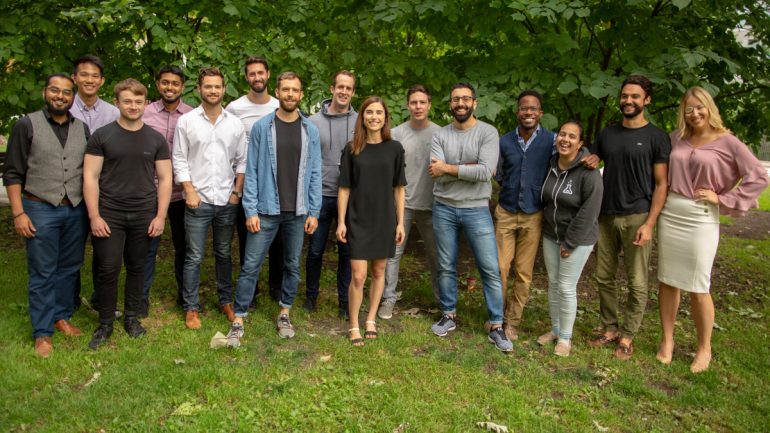In this series, brought to you by the Toronto-based native advertising technology company StackAdapt, you’ll join Vitaly Pecherskiy as he meets with top minds in the marketing and advertising industry to uncover how Canadian companies use innovative strategies and software to break through the digital noise.
In this installment of Canadian Growth Hackers, Vitaly speaks to Ryan Nahas, a founding member and Head of Sales at GrowthGenius, an AI-assisted outbound sales prospecting service for B2B companies. They talk about B2B content marketing and lead generation, what it takes to build outbound sales muscle, and how to build a “growth-minded” team.
Ryan, tell us – what does GrowthGenius do?
GrowthGenius helps B2B businesses generate more conversations with their ideal customers. Prospecting is the most challenging, frustrating and hated part of selling. Sales and marketing folks love building and strengthening relationships, but opening the door is always the hardest part.
We act as an extension of your sales team, automating the burden of time-consuming, unsystematic, and unreliable prospecting. We find you thousands of ideal prospects, craft highly personalized messages, and drive qualified interest right to your inbox. All you need to do is step in to close the deal.
How is the marketing function evolving in B2B companies now that there is a growing need for marketing teams to be accountable for driving revenue?
The more we talk to businesses, the more we see the “Lead Gen” or prospecting line item in the marketing budget rather than the sales budget. It makes total sense, if you think of prospecting as simply another lead source. Marketing brings in the leads; sales closes them.
“While sales interactions create human connections, content is where prospects go to to do research after the sales call has ended.”
The problem with this structure is the lack of accountability it creates. When marketing is generating the inbound leads through one-to-many channels like nurture funnels, demand gen campaigns, events, partnerships, etc., they end up employing the same strategy to one-to-one systems like cold-outbound messaging, even though a very different strategy is required for successful conversion.
Marketing teams need to work more closely with sales to drive towards a common goal, or a blended target, rather than fight over who gets credit for generating the lead that closed, or whose fault it is that leads aren’t converting.
In our conversations, you’ve mentioned that everything starts with persona development. Tell us what you do here, and how other companies should approach persona development?
Understanding your customer profile/buyer persona is very important, especially for young companies who have limited resources-like GrowthGenius and some of the businesses we work with. I’ve been reading a lot of your [Vitaly’s] writing over the years and liked your advice on saying no to customers and how to fire those that demand a disproportionate amount resources and bandwidth. We’ve definitely learned that the hard way over the past 18 months. As much as we want to help everybody, we’ve experimented enough to know to a high degree of certainty who will be a good fit before they sign a proposal.
Determining buyer personas has never been easier, at least in terms of getting quick feedback. The data is all available at your fingertips. Running sample experiments in multiple demographics with a small amount of ad spend, segmenting your outreach into different cohorts to determine if industry vertical, company size, geography, or CTA are factors in conversions.
Really, it’s all about doing what you can to optimize the people you’re messaging, what you’re saying, when you’re saying it, and then learning from your successes and failures to improve the relevancy over time.
In my view, any B2B company should develop strong outbound sales muscles if it wants to scale. How do you see the role of inbound marketing as the company scales?
Inbound is fueled by amazing, organic, and native content. For scaling, it’s crucial to give your reps as much context as possible when they reach out to prospects, to add clout online. Inbound usually comes at a much lower cost per lead.
Outbound, on the other hand, is one-to-one. It’s a conversation. It’s targeted and focused on connecting with individuals you are fairly certain will be a good fit for your product/service. We advise companies to invest in outbound only after they’ve identified their target buyer persona, mostly because the cost per lead tends to be a lot higher, and the targeted approach generally requires a lot more time/resources per outreach.
Content marketing is something GrowthGenius actively pushes for. What does it accomplish for you that you can’t do with sales?
At the end of the day, building a real relationship and showing someone you care will always be more meaningful.
Content helps close business. It makes a company believable, adds trust, validity, and clout. In closing our first dozen or so customers last year, we often used direct references, because we didn’t have any case studies or content that prospects could read to decide if they wanted to work with us. That isn’t sustainable. In the last few months, we’ve started pushing content more diligently, and it’s definitely helped bottom-of-funnel conversions.
While sales interactions create human connections, build relationships, and challenge the status quo, content is where prospects go to to do their research after the sales call has ended. The more they trust your content, the more likely they will become customers.
What is your philosophy around the type of content B2B companies should produce?
A lot of businesses create content that doesn’t directly support the gaps in the conversion or LTV equation. Content should always act as a solution to a problem. Is lead gen an issue? Create top-of-funnel content to bring more leads into the pipeline. Are demo calls going great, but proposals not converting? Drive content that makes it easy for prospects to believe that signing the proposal isn’t something they’ll regret. Are existing customers not adopting the platform as quickly as desired? Create helpful how-to guides or push webinar content by the customer success team.
Let’s quickly touch on how you build your team. I find the requirement of “growth-minded” interesting. What does that mean? How do you interview people for that?
That’s such an important quality to have when building a team from zero. We need adaptability, coachability, insatiable curiosity, a refusal to accept the status quo, and an understanding that the environment or situation you’re joining today at GrowthGenius isn’t perfect, but we have a vision for the future that is pretty cool. If you’re a builder in your own life, it’s pretty likely that you’re going to be excited about helping us build something amazing too. That’s what we mean by “growth-minded.”
In interviews, we ask questions like “What’s the last tough problem you solved?”, “What’s the last skill you learned?”, “What is next on your to-do list outside of work?”, and if the circumstances allow for it, “What do you want your legacy to be?” These questions make for a much more interesting interview.
Okay, bonus questions: can you share a company blog that you enjoy reading?
Every piece of content on the Gong.io blog seems to be written specifically for me.
What is one book every business person should read?
To Sell is Human by Daniel H. Pink. Our sales team would roll their eyes if they heard me say this, because “being more human” is something I talk about every day at the office. There’s a lot of tech, messenger-bots, and automation in our lives, but at the end of the day, building a real relationship and showing someone you care will always be more meaningful.



